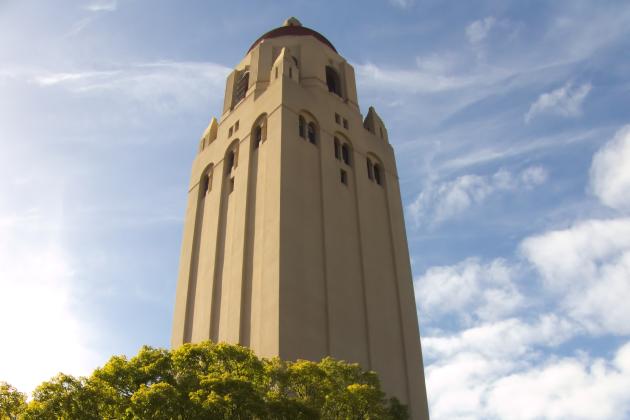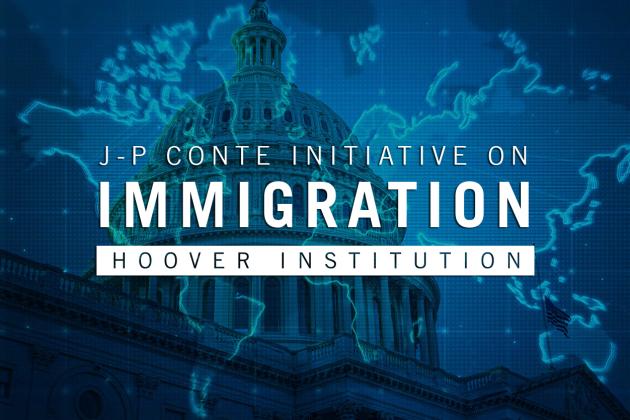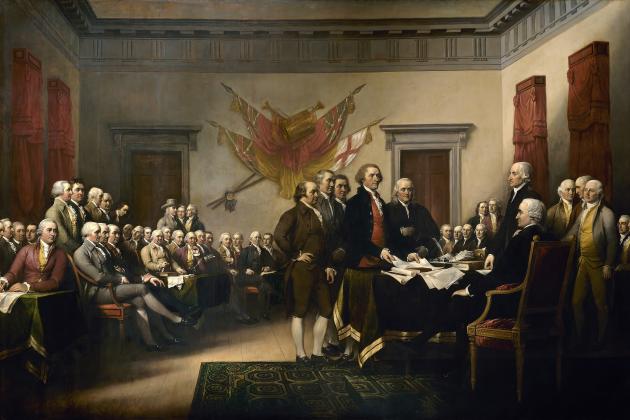PARTICIPANTS
Tom Hazlett, Geoff Baum, LeAnn Baum, Daniel Bjorkegren, Michael Boskin, John Cochrane, Bill Evers, David Friedman, LtCol Jer Garcia, Paul Gregory, John Gunn, Bob Hall, Rick Hanushek, Ken Judd, Veronique Kherian, James Lee, Lee Lockwood, Frederic Martenet, David Mulford, George Ou, Greg Rosston, John Shoven, CDR David Slayton, David Sosa, Richard Sousa, Jesse Sowell, John Taylor.
ISSUES DISCUSSED
Thomas Hazlett, former chief economist with the US Federal Communications Commission, presented his book The Political Spectrum: The Tumultuous Liberation of Wireless Technology on the history of spectrum regulation. In the moment that “net neutrality” is revoked, essentially deciding not to apply the utility regulation regime that telephones, radio, and TV worked under for most of the last century, the subject is certainly topical.
Contrary to conventional wisdom, the market for spectrum worked well until 1927, in just the way economists might expect. Property rights to spectrum emerged, evolved, and worked well.
Radio was, at first, considered only for point to point communication. It stayed that way until 1920, when the first broadcast occurred. Within 2 years there were 500 broadcasters. Contrary to the common allegation of “etheric bedlam” the market was actually orderly through 1926. Under the 1912 radio statute, the Department of Commerce enforced first come first serve rules, basically homesteader rights to spectrum in a geographic area. Those emergent property rights were registered with the Department of Commerce, and easily bought and sold.
Regulation emerged in much the way a public choice economist might predict. The regulators wanted much more discretion — they wanted to control who got to broadcast and what was said. The existing large commercial stations wanted to limit entry and competition. The National Association of Broadcasters quickly became a lobbying group and advocated “public interest, convenience, and necessity” to regulate. Herbert Hoover, the commerce secretary at the time, stopped enforcing first come first serve in 1926. Now there was chaos, the “breakdown in the law.” According to Hazlett, this was a strategic breakdown to get regulation going. That regulation was formalized in the 1927 Radio Act. The first sentence of the act preempted private rights to spectrum.
Now, rather than property rights, spectrum was allocated by a “Mother May I” system. It was first a Federal radio Commission in 1927. In 1932 it became the FCC, which took over authority of wires too.
As usual, regulation is quickly captured to stop competition and innovation.
Hazlett offered FM radio as the classic example. Howard Armstrong (famous inventor) in 1933 created FM radio, which as we know is technically much better than AM. He had to ask the FCC for spectrum. FCC experts said it wouldn’t work. In 1939 he finally got some spectrum allocation for FM, and started selling FM radios. In WWII civilian production ended. In 1945, broadcast TV lobbied the FCC for the FM spectrum, and the FCC moved FM from the 40 MHz range to 88-108, making all existing radios obsolete. Armstrong had to start over. When finally in the 1960s FM was allowed again, it immediately took over from AM for music; [as we know it has much wider frequency response, and “no static at all”.] That’s a nutshell of “Mother May I” regulation — it suppresses competition and deters innovative technologies, in this case for a quarter century.
People did notice the severe anti-competitive and anti-innovative properties in the regulated regime. Hazlett noted “two paradigms:”
1) In likely the most famous speech by an American regulator, May 9 1961, FCC chairman Newton N. Minow characterized TV as a “vast wasteland.” He forced stations to show “public interest” to get a license renewal.
In the early 1960s, cable began to compete. Broadcasters naturally tried hard to stop it. From 1948-to the 1960s, cable only extended the range of broadcast TV signals. But in the 60s, cable started to offer competing broadcasts. The over the air broadcasters got Minow to block cable, on the grounds that cable would destroy broadcasters’ profitability, and therefore their provision of public interest news and other public interest programming. This lasted until the late 1970s.
2) In an equally famous and vilified speech, FCC chairman Mark Fowler argued, “TV is just a toaster with pictures.” He argued for competition, free entry, entrepreneurship and letting people choose. He argued against the “public interest” standard, and for minimalist regulation.
Cable was deregulated, and immediately produced hundreds of channels, including CSPAN, and the all-news CNN. The result was, ironically much more news and public affairs, just what FCC said it was protecting, in place of networks’ 15-minute nightly news.
Spectrum then entered a gradual decades-long liberalization. 1st generation wireless mobile got licenses in the 1980s, though the technology was announced in 1945. Getting this spectrum allocation was called the “30 years’ war.”
This deregulation was part of the late 70s and early 80s deregulatory revolution, and was slow. In the 1970s, the FCC decided that only a monopoly can do cell phone service, and gave it to Bell. By the 1980s radicals said maybe there could be 2 cell phone companies. The department of justice had to sue the FCC to get more than one license.
Even in the first generation, there were only 2 competitors, and standards were set by the government. By early 2000 though, many countries auctioned licenses and allowed liberal defacto property rights. Regulators now allow mobile licensees to figure out networks, architecture (size, location, and power of stations), and use their own applications. In 2005, the iPhone was like FM, and needed spectrum. But this time it didn’t have to ask permission. Apple negotiated with Verizon and AT&T, initially going with AT&T exclusive for the iPhone. It ended up that the price was negative — carriers wanted the iPhone on their network enough to pay for it.
2- 5 G wireless and the “internet of things,” is built through private coordination. But it is fragile. Regulators have simply interpreted their mandate for “public interest,” and that liberalization and rights are working.
Most countries had state monopolies on telephones phones. Now most have privatized telephone and wireless. Fixed line phones are declining. Market competition and rights have expanded; “Mother May I” regulation has receded.
Where are we now? The job not half done. Most spectrum is still regulated. Of the “beach front” under 4 Ghz, 15% (mobile) is largely unrestricted, assigned by auction. About half is allocated to government, military, and forestry.
The basic structure hasn’t changed. Each block of spectrum is allocated case by case. Liberalization is a choice by the regulator under old law. The same politics recur in each block. In the 2010 national broadband plan, the FCC wanted to bring more spectrum to market. TV had been allocated wide swaths of spectrum in 1939-1953, and much of it was unused. The basic plan was a two-sided auction. Broadcast TV said what price they would sell rights back to government, even though the licenses were not really property rights. The FCC then auctioned the newly available spectrum. The FCC also changed channel assignments involuntarily on stations. (Having adjacent blocks of spectrum is useful.)
Hazlett suggests a different structure with an “overlay.” The FCC should auction immediately everything that TV stations are not using. Then, give both stations and bidders the right to negotiate to move frequencies with TV stations.
The FCC did not do this because it worried there would be too many holdouts, and thought it had to use its coercive power to move channel assignments. There are still 35 over the air TV channels, so it is a very partial success.
Broadcasters said they wanted $84 billion to give up spectrum, far more than the entire value of the companies. The FCC worked down the supply curve, asking for less and less. But clearly stations were bidding ridiculously high. Meanwhile broadcasters are leaving the industry, evidently shown the spectrum wasn’t worth a lot. 75% of the TV band is still not opened 10 years later.
Much discussion followed on the right way to do new spectrum auctions. Bob Hall advocated we read the second half of Coase’s theory, and Richard Epstein’s book on eminent domain. One can get around holdup costs with a well-defined intervention.
- John Cochrane









